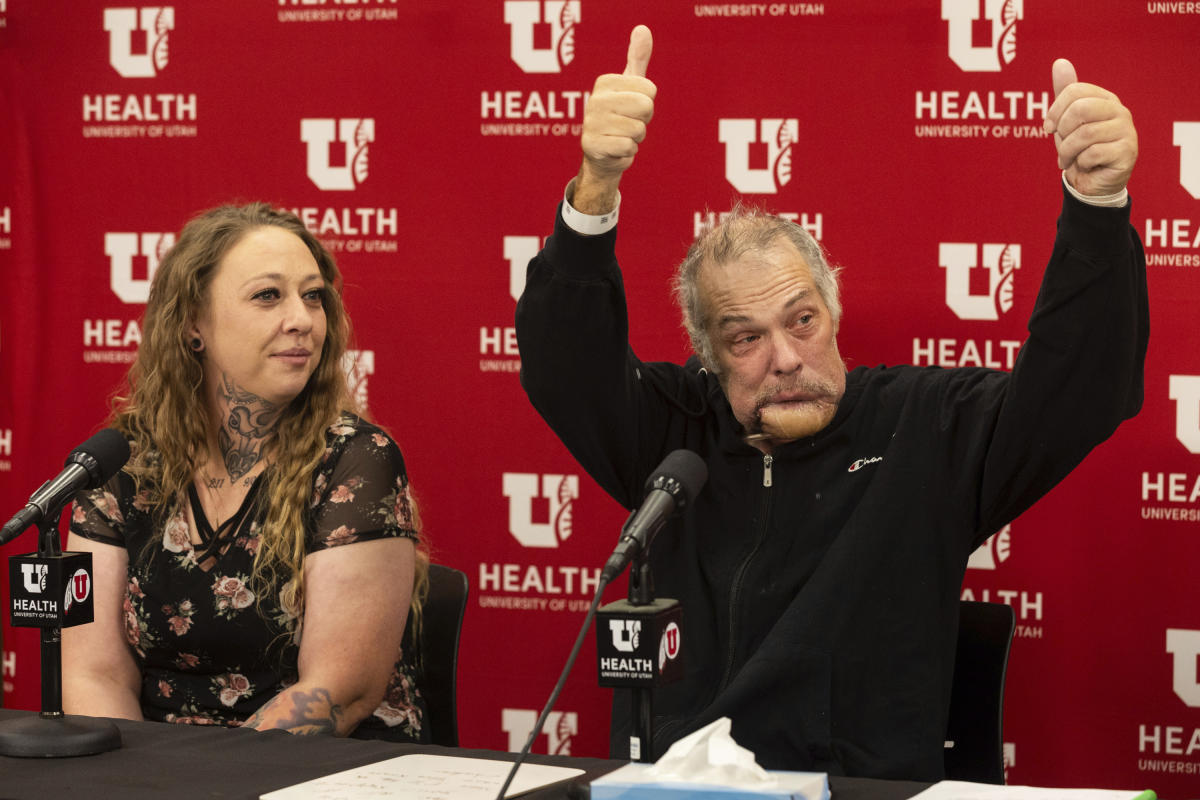Navigation
Install the app
How to install the app on iOS
Follow along with the video below to see how to install our site as a web app on your home screen.
Note: This feature may not be available in some browsers.
More options
You are using an out of date browser. It may not display this or other websites correctly.
You should upgrade or use an alternative browser.
You should upgrade or use an alternative browser.
the "Headline That Caught My Attention or the WTF" thread
- Thread starter wader
- Start date
longcast
Well-Known Angler
Mortgage rates pummel homebuyers again, edge closer to 8%
The average rate on the 30-year fixed mortgage jumped to 7.57% this week from 7.49% a week prior, according to Freddie Mac.
The Average Human Body Temperature Is Not 98.6 Degrees
Here’s why we appear to be getting cooler, and what that could mean when it comes to fevers.Over the past few decades, evidence has been mounting that the average human body temperature is not really 98.6 degrees Fahrenheit. Instead, most people’s baseline is a little bit cooler.
The standard of 98.6 was established over 150 years ago by the German physician Dr. Carl Wunderlich, who reportedly took over a million measurements from 25,000 people. Temperatures ranged from 97.2 to 99.5, and the average was 98.6. Dr. Wunderlich also established 100.4 degrees as “probably febrile.”
However, a study published in September that evaluated the temperatures of more than 126,000 people between 2008 and 2017 found that the average is closer to 97.9 degrees. Other modern-day studies have reported similar numbers.
Experts who study body temperature have differing opinions about why we appear to have gotten cooler over time, and whether that matters when it comes to evaluating fevers and diagnosing infections.
Why 98.6 is off base
Some researchers say it could just be a measurement issue — Dr. Wunderlich might have assessed temperatures using different methods and standards than we do today. One account reports that he used a foot-long thermometer that went into a person’s armpit.Many factors can influence a body temperature reading, the most significant being where you take it: Rectal temperatures are reliably higher than oral temperatures, which are reliably higher than readings taken from the skin. Body temperature is also influenced by the time of day, whether it’s hot or cold outside and even whether the person just had something to eat or drink. Readings can also vary from thermometer to thermometer, depending on how they are calibrated.
Comparing historical and modern-day data gives you “a hodgepodge mixture of observations,” said Dr. Philip Mackowiak, an emeritus professor of medicine at the University of Maryland School of Medicine, who, in a 1992 paper, was one of the first researchers to scrutinize Dr. Wunderlich’s conclusions. The drop in temperature may be “a true phenomenon,” he added, “but there’s no way of knowing because the data are so varied.”
Other experts think humans really have gotten cooler over the past 150 years. Our temperatures may have declined because “we are so lucky to be healthier than we used to be,” said Dr. Julie Parsonnet, a professor of medicine and of epidemiology and population health at Stanford Medicine, who led the September study on body temperature.
For instance, it could be that many people in Dr. Wunderlich’s sample had slightly elevated temperatures from low-grade inflammation. Better treatment of infections, improved dental care and the development and use of medications like statins and nonsteroidal anti-inflammatory drugs may all have contributed to a decline in inflammation since the 19th century, which in turn lowered people’s average temperature, Dr. Parsonnet said.
Regardless of the reason for the shift, the experts interviewed for this article agreed that 98.6 degrees should no longer be considered the universal human standard. But instead of shifting the average temperature down a degree or so, it should be given as a range, said Dr. Waleed Javaid, a professor of medicine at the Icahn School of Medicine at Mount Sinai, who published a 2019 review paper on body temperature.
A range would account for the natural variability in temperature that occurs across gender and age — women tend to run slightly warmer than men, and older adults run cooler than younger people. Additionally, everyone’s body temperature fluctuates throughout the day — it is typically lowest in the morning and highest in the late afternoon.
“Like there’s a range for heart rate, there’s a range for blood pressure,” temperature also has a range, Dr. Javaid said.
What counts as a fever
If we redefine “normal” human body temperature, then what registers as abnormal?The Centers for Disease Control and Prevention says that temperatures of 100.4 and above qualify as a fever — a roughly two-degree increase from 98.6. But if the average human temperature is lower, it’s possible that the temperature indicating a fever could be lower, as well.
Dr. Parsonnet would like to see a personalized approach to fever, where doctors compare each patient against their own baseline so that low-grade fevers aren’t missed in people who run cooler. The mission is somewhat personal for her: Dr. Parsonnet’s mother-in-law has a heart infection that went undiagnosed for months because she never registered as being feverish. Her temperature was around 98.6, but, Dr. Parsonnet said, that “was not normal for her, for her age.”
To Dr. Mackowiak, this individualized approach would be ideal, but it’s unrealistic given the time constraints doctors and nurses are already under.
He and Dr. Javaid are also not as concerned about the possibility of low-grade fevers being missed because of the current temperature standards. Instead of changing the definition of a fever, they said the solution may be to place less of an emphasis on fever overall, and to think of it as one sign among many — something that many doctors already do. (This advice applies to parents, as well as physicians.)
If a temperature is sky-high, that’s important information, Dr. Javaid said, but “the temperature is not the only thing one should look at.”
Avenger
Well-Known Angler
The Average Human Body Temperature Is Not 98.6 Degrees
Here’s why we appear to be getting cooler, and what that could mean when it comes to fevers.
Over the past few decades, evidence has been mounting that the average human body temperature is not really 98.6 degrees Fahrenheit. Instead, most people’s baseline is a little bit cooler.
The standard of 98.6 was established over 150 years ago by the German physician Dr. Carl Wunderlich, who reportedly took over a million measurements from 25,000 people. Temperatures ranged from 97.2 to 99.5, and the average was 98.6. Dr. Wunderlich also established 100.4 degrees as “probably febrile.”
However, a study published in September that evaluated the temperatures of more than 126,000 people between 2008 and 2017 found that the average is closer to 97.9 degrees. Other modern-day studies have reported similar numbers.
Experts who study body temperature have differing opinions about why we appear to have gotten cooler over time, and whether that matters when it comes to evaluating fevers and diagnosing infections.
Why 98.6 is off base
Some researchers say it could just be a measurement issue — Dr. Wunderlich might have assessed temperatures using different methods and standards than we do today. One account reports that he used a foot-long thermometer that went into a person’s armpit.
Many factors can influence a body temperature reading, the most significant being where you take it: Rectal temperatures are reliably higher than oral temperatures, which are reliably higher than readings taken from the skin. Body temperature is also influenced by the time of day, whether it’s hot or cold outside and even whether the person just had something to eat or drink. Readings can also vary from thermometer to thermometer, depending on how they are calibrated.
Comparing historical and modern-day data gives you “a hodgepodge mixture of observations,” said Dr. Philip Mackowiak, an emeritus professor of medicine at the University of Maryland School of Medicine, who, in a 1992 paper, was one of the first researchers to scrutinize Dr. Wunderlich’s conclusions. The drop in temperature may be “a true phenomenon,” he added, “but there’s no way of knowing because the data are so varied.”
Other experts think humans really have gotten cooler over the past 150 years. Our temperatures may have declined because “we are so lucky to be healthier than we used to be,” said Dr. Julie Parsonnet, a professor of medicine and of epidemiology and population health at Stanford Medicine, who led the September study on body temperature.
For instance, it could be that many people in Dr. Wunderlich’s sample had slightly elevated temperatures from low-grade inflammation. Better treatment of infections, improved dental care and the development and use of medications like statins and nonsteroidal anti-inflammatory drugs may all have contributed to a decline in inflammation since the 19th century, which in turn lowered people’s average temperature, Dr. Parsonnet said.
Regardless of the reason for the shift, the experts interviewed for this article agreed that 98.6 degrees should no longer be considered the universal human standard. But instead of shifting the average temperature down a degree or so, it should be given as a range, said Dr. Waleed Javaid, a professor of medicine at the Icahn School of Medicine at Mount Sinai, who published a 2019 review paper on body temperature.
A range would account for the natural variability in temperature that occurs across gender and age — women tend to run slightly warmer than men, and older adults run cooler than younger people. Additionally, everyone’s body temperature fluctuates throughout the day — it is typically lowest in the morning and highest in the late afternoon.
“Like there’s a range for heart rate, there’s a range for blood pressure,” temperature also has a range, Dr. Javaid said.
What counts as a fever
If we redefine “normal” human body temperature, then what registers as abnormal?
The Centers for Disease Control and Prevention says that temperatures of 100.4 and above qualify as a fever — a roughly two-degree increase from 98.6. But if the average human temperature is lower, it’s possible that the temperature indicating a fever could be lower, as well.
Dr. Parsonnet would like to see a personalized approach to fever, where doctors compare each patient against their own baseline so that low-grade fevers aren’t missed in people who run cooler. The mission is somewhat personal for her: Dr. Parsonnet’s mother-in-law has a heart infection that went undiagnosed for months because she never registered as being feverish. Her temperature was around 98.6, but, Dr. Parsonnet said, that “was not normal for her, for her age.”
To Dr. Mackowiak, this individualized approach would be ideal, but it’s unrealistic given the time constraints doctors and nurses are already under.
He and Dr. Javaid are also not as concerned about the possibility of low-grade fevers being missed because of the current temperature standards. Instead of changing the definition of a fever, they said the solution may be to place less of an emphasis on fever overall, and to think of it as one sign among many — something that many doctors already do. (This advice applies to parents, as well as physicians.)
If a temperature is sky-high, that’s important information, Dr. Javaid said, but “the temperature is not the only thing one should look at.”
Still looking for that "rolleyes" emoji in tbe reactions.
Google challenged??Still looking for that "rolleyes" emoji in tbe reactions.

longcast
Well-Known Angler

Hamas 'Day of Rage' puts Israel, police around the world on alert
Israeli authorities are warning people to “be alert" Friday and keep distance from protests as Hamas has called on supporters to carry out a “Day of Rage."
Security around the world has been ramped up on Friday as Israeli authorities are warning the public about Hamas’ call for a "Day of Rage" targeting its people and Jews.
longcast
Well-Known Angler

Video US police on high alert as Hamas calls for ‘Day of Rage’
Police departments in major U.S. cities are on a heightened state of alert in preparation of potential violence.
longcast
Well-Known Angler

New York, California exodus continues, but 'catastrophic effect' of Biden economy may be on the way: experts
Business experts say that Americans are continuing to flee blue states like California and New York in droves over "oppressive" policies and high taxes.
Americans are continuing to flee liberal states like New York and California for better home prices and taxes, but business experts warn the -------- economy is creating new problems for happy movers.
On Finch Capital founder and real estate investor Steven Pesavento said that during the pandemic, employees realized they no longer needed to live in the cities where they worked, which created new opportunities for a flexible lifestyle.
"It opened up an opportunity for them to get away from, you know, the high cost of living, the kind of oppressive civil policies and business policies, the high taxes, all of those things that they were willing to stay put over because it was what they needed for their job," Pesavento said.
New York experienced the second-biggest drop next to California, losing just under $300 million from its yearly tax base.
"They're chasing lower taxes, they're chasing better business policies, and they're chasing a better way of living," Pesavento said. "They're also looking for other people who believe what they believe and to kind of get away from all the craziness that's been happening in schools in those local areas where they used to live."
Real estate coach and business expert Josh Cadillac told Fox News Digital that migration to red states remains strong from its peak in 2021. He said that many people decided to move to places where they were "treated like adults" and could circumvent the paranoia and government restrictions that came along with the pandemic.
While the commercial and office market remains muscular in Florida, Cadillac said the entire New York tax base has been "decimated" and the city is struggling to repurpose building vacancies.
"What we saw was one of the greatest domestic migrations we've seen since the end of slavery. I mean, people have moved in unbelievable droves. They voted with their feet to leave places where they lost their autonomy, to go to places where they could," he said.
However, he worried that the "real catastrophic effect" of the economy may still be on the horizon, calling the restart of student loan payments "a wild card."
Lush noted that the average American household was up $6,000 under the previous administration. Today, the country is experiencing "stagflation," wherein income has not increased, but inflation has.
"We're technically going backward at a staggering level," he said.
longcast
Well-Known Angler

Knife-wielding attacker shouts 'Allahu akbar' and kills teacher in French school amid Hamas-Israel war: report
A teacher was killed by an attacker in northern France Friday. Reports say the Chechen immigrant was already on a state watchlist as being a potential security risk. Another teacher was injured in the attack.
A Chechen immigrant on France's extremist watchlist allegedly stabbed a teacher to death Friday morning and wounded two others in a suspected terror attack that the country's president called an assassination.
It happened outside a school in the city of Arras, about 115 miles north of Paris, near the border with Belgium, and a suspect is in custody, according to France Interior Minister Gerald Darmanin.
French President Emmanuel Macron said during a news briefing that police also stopped a second attempted attack after the stabbing, which he said shows "the barbarism of Islamic terrorism."
longcast
Well-Known Angler

Trans athletes take 1st and 2nd place in Chicago women’s cycling event
Tessa Johnson and Evelyn Williamson, two transgender female cyclists, took the top spots on the podium in a women's event at race in Chicago last weekend.
wader
Well-Known Angler
Russian drone pilots tried to figure out who was on their side by dropping grenades and seeing which way soldiers ran, Ukrainian commander says

Russian drone pilots tried to figure out who was on their side by dropping grenades and seeing which way soldiers ran, Ukrainian commander says
Whether the soldiers ran toward Russian or Ukraine's lines revealed which side they were on, a Ukrainian commander told The Washington Post.
longcast
Well-Known Angler

Autoworker union president who donned 'eat the rich' shirt is in top 5% of earners
Shawn Fain, the president of the UAW labor union, has worn an "eat the rich" shirt at multiple events, despite earning hundreds of thousands of dollars in income in top union role.
Fain's annual salary of $347,389 places him in the top 5% of earners in his home state of Indiana where, according to a Forbes analysis, individuals whose salary exceeds $192,928 per year are in the top 5%.
If Fain's new salary as president matches his predecessor, former UAW President Ray Curry, his union income increased to $267,126 and his overall salary — including what he earns from the non-profit UAW Chrysler Skill Development & Training Program — increased to $454,385, a salary that would make him a top 1% earner.
Now this is using the old noggan...
Why Tugboats Are Key to the $19 Billion Overhaul of Kennedy Airport
Renovating one of the world’s busiest airports is replete with engineering challenges, such as how to circumvent the area’s overburdened roadways.To turn New York City’s outmoded Kennedy Airport into a collection of gleaming, modern terminals connected by smooth, untangled roadways, you must start with one of nature’s most basic building blocks: tons and tons of rocks.
But J.F.K., set hard against Jamaica Bay and surrounded by dense neighborhoods and congested highways, is not the easiest place to deliver hundreds of truckloads of stone each day. So, the pathway to unlocking the future of international air travel in New York will be on the water.
Barges, pushed and pulled by tugboats, have started wending over a series of waterways, carrying the basic ingredients of the $19 billion project that officials hope will transform the long-maligned airport. Overhauling J.F.K., one of the world’s busiest airports, is replete with engineering challenges, like how to circumvent metropolitan region’s overburdened roadways.
The journey these mounds of rocks and sand are taking is a daylong float down the Hudson River, through New York Harbor, under the Verrazzano-Narrows Bridge, past Coney Island and across the bay to a makeshift dock at the western edge of the airport.
In essence, they are arriving at the airport through a side door, not the front door.

Debris and construction materials are ferried to and from the airport on barges via a makeshift dock.Credit...Anna Watts for The New York Times
After trips as long as 125 miles from quarries as far away as Catskill, N.Y., the rocks do land in dump trucks, but those trucks stay on J.F.K.’s 5,000-acre campus rather than adding to the congestion on the roads of Southeast Queens.
Rick Cotton, executive director of the Port Authority of New York and New Jersey, which runs Kennedy, estimated that the scheme could eliminate as many as 300,000 truck trips to and from Kennedy over the course of the project. Those trips would have spanned 1.5 million miles, he said.
wader
Well-Known Angler
What?????

 www.yahoo.com
www.yahoo.com

Female sergeant demoted for pulling down colleague’s trousers and licking her forehead as ‘banter’
A female sergeant has been demoted for pulling down a colleague’s trousers and licking her forehead as “banter”, a court-martial heard.
wader
Well-Known Angler

Montana man to return home from hospital weeks after grizzly bear bit off lower jaw
A Montana man who was mauled by a grizzly bear that bit off the front of his lower jaw is ready to return home after five weeks in a Utah hospital, a physician and his family said Friday during a news conference. Rudy Noorlander, who answered most questions at the University of Utah hospital by...
longcast
Well-Known Angler

Biden trips in Philadelphia while climbing steps to podium on stage: video
President Biden tripped twice while going up several steps on the way to a podium at a Philadelphia rally Friday to tout his economic agenda.
wader
Well-Known Angler

FAA Warns That Falling Satellites Are Going to Start Killing People
Orbital Killer The Federal Aviation Administration has sounded the alarm on the danger of falling Starlink satellites, and SpaceX is not happy. SpaceX's satellites, which are stationed in low-Earth orbit, are intended to only last five years before de-orbiting. Their expendable nature has an...
longcast
Well-Known Angler
I would not worry about it. You have a much more realistic chance of death by an illegal or a suicide bomber than a satellite. That’s what we should be talking about!
FAA Warns That Falling Satellites Are Going to Start Killing People
Orbital Killer The Federal Aviation Administration has sounded the alarm on the danger of falling Starlink satellites, and SpaceX is not happy. SpaceX's satellites, which are stationed in low-Earth orbit, are intended to only last five years before de-orbiting. Their expendable nature has an...www.yahoo.com

wader
Well-Known Angler

Rescuers descended into a deep cave to rescue a trapped dog – then they found a bear
Firefighters encountered an unexpected challenge while rescuing a dog trapped in a Tennessee cave: A black bear was also there.
longcast
Well-Known Angler

Hamas terror attack fuels conservative concerns about border security amid migrant crisis
The terror attack by Hamas against Israel launched last week has refueled concerns from conservative officials and Republican lawmakers about the security of the U.S. border.
Members online
Total: 768 (members: 11, guests: 757)
Latest articles
-
The Biggest Lie in Striped Bass History Started With Two FishThat’s it. That’s the number. Two. For thirty years, the entire Atlantic coast striped bass...
- george
- Updated:
- 3 min read
-
Recreational Anglers Deserve an ApologyI've Been Saying This All Along: Recreational Anglers Deserve an Apology The data is finally in...
- george
- Updated:
- 6 min read
-
Abu Garcia's Beast SeriesAbu Garcia's Beast Series: Revolutionary Equipment for the Modern Swimbait Revolution October...
- george
- Updated:
- 6 min read
-
World's Lightest Spinning ReelGame-Changer or Gimmick? The Daiwa LUVIAS ST Claims to Be the World's Lightest Spinning Reel An...
- george
- Updated:
- 4 min read
-
New York Fluked Itself!Fluke Management in 2025: Regulators Got It Wrong Halfway through this season New York anglers...
- george
- Updated:
- 2 min read
